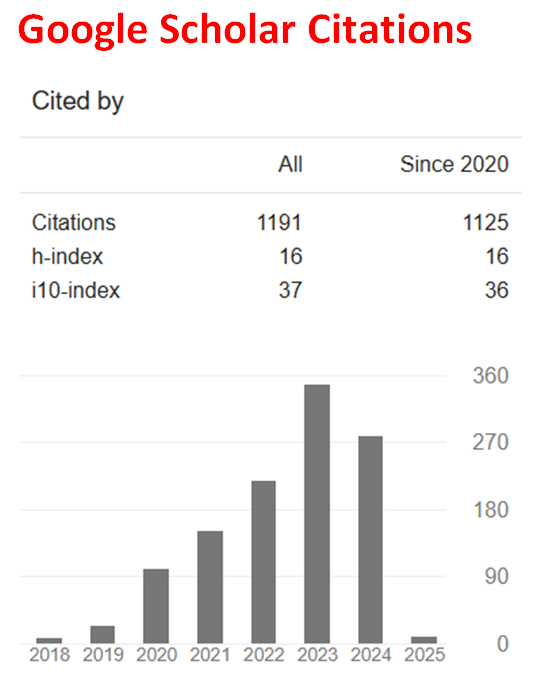A Parametric Cox Proportional Hazard Model with Application
Abstract
Survival analysis has become integral to clinical studies, especially in emerging diseases and terminal ailments. This study focused on improving the popular Cox PH model. The new method developed is a parametric type, incorporating the hazard rate of the exponential distribution. It was noted that though the functional form of the Cox PH model was altered, the assumptions were upheld. Additionally, the new model parameters were estimated using the same maximum partial likelihood as the Cox model. Data on the survival times of 137 patients who underwent bone marrow transplants were deployed, and the proposed parametric Cox PH model proved superior to the Cox PH model.
References
Laird, N. M., & Ware, J. H. (1982). Random-effects models for longitudinal data. Biometrics, 963-974. https://doi.org/10.2307/2529876
Cox, D. R. (1972). Regression models and life-tables. Journal of the Royal Statistical Society: Series B (Methodological), 34(2), 187-202. https://doi.org/10.1111/j.2517-6161.1972.tb00899.x
Ibrahim, J. G., Chu, H., & Chen, L. M. (2010). Basic concepts and methods for joint models of longitudinal and survival data. Journal of Clinical Oncology, 28(16), 2796. https://doi.org/10.1200/JCO.2009.25.0654
Asar, Ö., Ritchie, J., Kalra, P. A., & Diggle, P. J. (2015). Joint modelling of repeated measurement and time-to-event data: an introductory tutorial. International Journal of Epidemiology, 44(1), 334-344. https://doi.org/10.1093/ije/dyu262
Henderson, R., Diggle, P., & Dobson, A. (2000). Joint modelling of longitudinal measurements and event time data. Biostatistics, 1(4), 465-480. https://doi.org/10.1093/biostatistics/1.4.465
Rizopoulos, D. (2012). Joint models for longitudinal and time-to-event data: With applications in R. CRC Press. https://doi.org/10.1201/b12208
Wulfsohn, M. S., & Tsiatis, A. A. (1997). A joint model for survival and longitudinal data measured with error. Biometrics, 330-339. https://doi.org/10.2307/2533118
Dupuy, J.-F., & Mesbah, M. (2002). Joint modeling of event time and nonignorable missing longitudinal data. Lifetime Data Analysis, 8, 99-115. https://doi.org/10.1023/A:1014871806118
Allison, P. D. (2010). Survival analysis using SAS: a practical guide. SAS Institute.
Allison, P. D. (2018). Event history and survival analysis. In The reviewer's guide to quantitative methods in the social sciences (pp. 86-97). Routledge. https://doi.org/10.4324/9781315755649-7
Cox, D. R. (2018). Analysis of survival data. Chapman and Hall/CRC.
Fox, J. (2016). Using the R commander: a point-and-click interface for R. Chapman and Hall/CRC.
Fox, J., & Weisberg, S. (2018). An R companion to applied regression. Sage Publications.
Hosmer Jr, D. W., Lemeshow, S., & May, S. (2008). Applied survival analysis: regression modeling of time-to-event data (Vol. 618). John Wiley & Sons. https://doi.org/10.1002/9780470258019
Therneau, T., et al. (2015). A package for survival analysis in S. R package version, 2(7), 2014.
Therneau, T. M. (1997). Extending the Cox model. In Proceedings of the first Seattle symposium in biostatistics: survival analysis (pp. 51-84). Springer. https://doi.org/10.1007/978-1-4684-6316-3_5
Samawi, H., Yu, L., & Yin, J. (2023). On Cox proportional hazards model performance under different sampling schemes. PLOS ONE, 18(4), e0278700. https://doi.org/10.1371/journal.pone.0278700
Scheaffer, R. L., Mendenhall, W., Ott, L., & Gerow, K. (1990). Elementary survey sampling (Vol. 501). Duxbury Press California.
Bradburn, M. J., Clark, T. G., Love, S. B., & Altman, D. G. (2003). Survival analysis part II: multivariate data analysis--an introduction to concepts and methods. British Journal of Cancer, 89(3), 431-436. https://doi.org/10.1038/sj.bjc.6601119
Clark, T. G., Bradburn, M. J., Love, S. B., & Altman, D. G. (2003). Survival analysis part IV: further concepts and methods in survival analysis. British Journal of Cancer, 89(5), 781-786. https://doi.org/10.1038/sj.bjc.6601117
Bradburn, M. J., Clark, T. G., Love, S. B., & Altman, D. G. (2003). Survival analysis part III: multivariate data analysis--choosing a model and assessing its adequacy and fit. British Journal of Cancer, 89(4), 605-611. https://doi.org/10.1038/sj.bjc.6601120
Kartsonaki, C. (2016). Survival analysis. Diagnostic Histopathology, 22(7), 263-270. https://doi.org/10.1016/j.mpdhp.2016.06.005
Nieto, F. J., & Coresh, J. (1996). Adjusting survival curves for confounders: a review and a new method. American Journal of Epidemiology, 143(10), 1059-1068. https://doi.org/10.1093/oxfordjournals.aje.a008670
Windpassinger, M., Plattner, O., Gemeiner, J., Röder, G., Baumann, A., Zimmerman, N. M., & Sessler, D. I. (2016). Pharyngeal oxygen insufflation during AirTraq laryngoscopy slows arterial desaturation in infants and small children. Anesthesia & Analgesia, 122(4), 1153-1157. https://doi.org/10.1213/ANE.0000000000001189
Bland, J. M., & Altman, D. G. (2004). The logrank test. BMJ, 328(7447), 1073. https://doi.org/10.1136/bmj.328.7447.1073
Dietz, K., Gail, M., Krickeberg, K., Samet, J., & Tsiatis, A. (2002). Statistics for biology and health. Survival Analysis, 7.
Gail, M., Krickeberg, K., Samet, J., Tsiatis, A., & Wong, W. (2007). Statistics for biology and health. Springer.

This work is licensed under a Creative Commons Attribution 4.0 International License.
.jpg)

